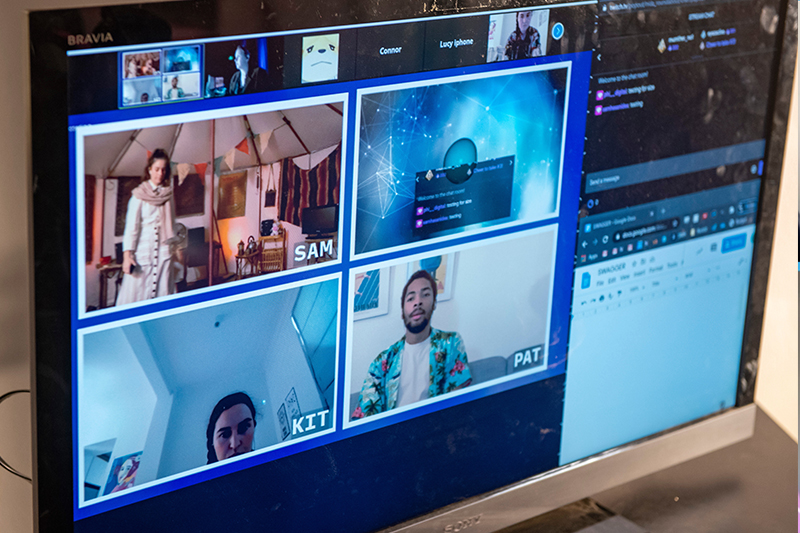
Photo: Roundabout online.
NIDA’s Digital Theatre Festivalin Augustchallenged and reinventedonline storytelling, usingmultipleplatforms to interact with audiences in new and inventive ways.
Working with international and Australian directors who are known for their creative digitalexpertise, the season of sixworld premieresweremade entirely for an online audience.
For theBachelor of Fine Arts (Technical Theatre and Stage Management)students and tutors workingin technicalrolesand as Project Managers on the productions,the Festival meant learningnewdigitalskills in cinematography, editing, sound recording and lighting.
‘The Festivalrepresented a hugely innovative leap into new mediums and methods for theatrical storytelling,’ saidNIDADirector Centre for Technology, Production and Management Graham Henstock. ‘Embracing this innovation introduced a unique set of challenges forTechnicalTheatre andStageManagement students.
‘Whilethey are taught how toutilisemany different technologies,allthe students needed to quicklyidentify,experimentand achieveproficiencywith equipment and processes that they had notencounteredbefore.’
‘The fact that they adapted so quickly and successfully delivered six technically complex productions is a testament to their ingenuity, resilience and talent. I am enormously proud of the work that they produced.’
Roundabout: ‘Behind one mountain is often another’
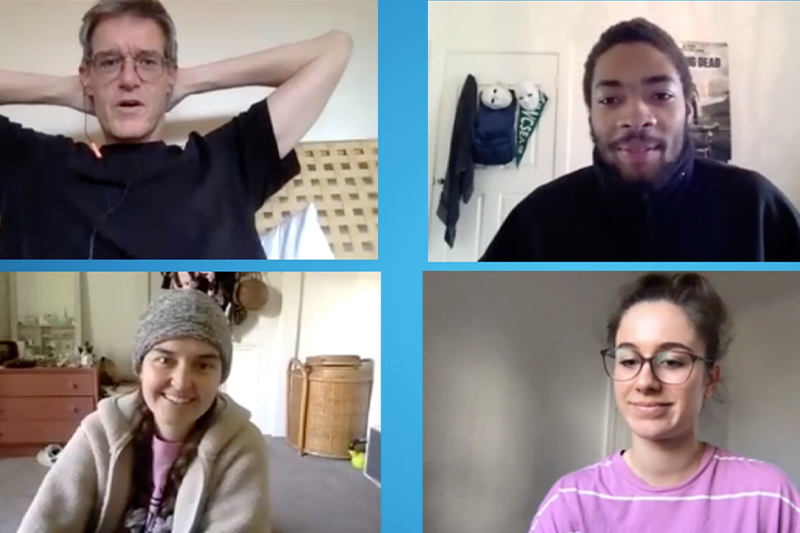
Photo: Roundabout online.
Daniel Herten is a third-year Bachelor of Fine Arts (Technical Theatre and Stage Management) student and was Audio-Visual Designer, Technical Supervisor and Editor onRoundabout.
The live audience were active co-creators on the Twitch channel, used by video-gamers, and determined the course of action. Even over six performances, not all possibilities were exhausted.
‘A big challenge for us was learning to communicatewithour international guest director, Sean Stewart, who was inLos Angelesduring our technical rehearsal sessions.We had to completely overhaul our working hours during the pre-production and show run weeks,’ said Daniel.
The technical team spent weeks preparing plans and layouts around video system schematics, finding reliable ways to move data across the internet and learning about audiolatency.
‘At one stage we started getting a bit hysterical as a new video system schematic was coming out at about every two days,’ said Daniel. ‘We had to apply knowledge of software development,codingand gaming to get theshowoffofthe ground. The process was full of compromise and we all went into it with the understanding that much of what we were trying was uncharted for us and experimental.
‘This mindset resulted in discussions where anyone, regardless of their titled role, could pitch in and suggest new angles to explore in the various aspects of the show such as technical design or even the script.’
Daniel said that the difficult part about putting this show together was planning for changes and unforeseen challenges. ‘Because we were trying to do things we had not done before, such as live streaming video and having live animation, the actual infrastructure that we built through our system tofacilitatethese components of the show had to be bigger thaninitially required incase we wanted to add or change things later.
‘Weended up making many changes close to the performances as we discovered things that we could not haveidentifiedaboutthe show when rehearsing in our own homesdue to COVID.’
Daniel said that Sean often spoketo the students about the ‘minimalviableproduct’ and developing aspects of the show in stages of functionality to reduce the risk ofattemptingsomething that was notfeasible.
‘I quickly discovered that when working innew territory, as Sean explained� “behind one mountain is often another”.Afterstarting to take on this mindset in my work, I have become a much better audio-visual designer and my team has improved in their ability to managea very complicatedtechnical system.’
Theatrical monologues meet live streaming
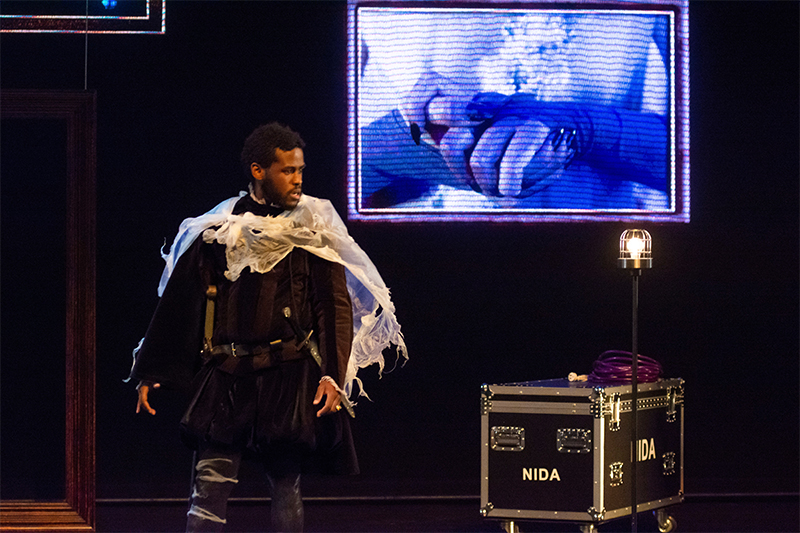
Ghost Lightswasan innovativeintegration of theatre and digital media in performance, directed by theatre and new media artist Katy Alexander, who was resident director at California Institute of Arts and trained with Robert Lepage and The Builders Association (NYC).
It beganwith theatrical characters from Shakespeare, Pirandello, Ibsen and NIDA’s Head of Writing Dr Stephen Sewell,delivering iconic monologues in ashort film.
NIDA Bachelor of Fine Arts (Technical Theatre and Stage Management) students and Project ManagersMaliTauro-Cesca and Morgan Moroney explained that to create these films,the technical teamhad to experiment in lighting for film, portable sound recording, and learn new skills in cinematography and editing.
The shortfilms were then uploaded to social media wheretheonlineaudiencecouldinteractwithandlearn aboutthe characters theywouldlatermeet ina liveshow. Thestage playwasstreamed liveonYouTubefroman emptyParade Theatre.
The overall effect is a live, digital experience that the audience has interacted with throughout the entire process.
Three-part showover Zoom
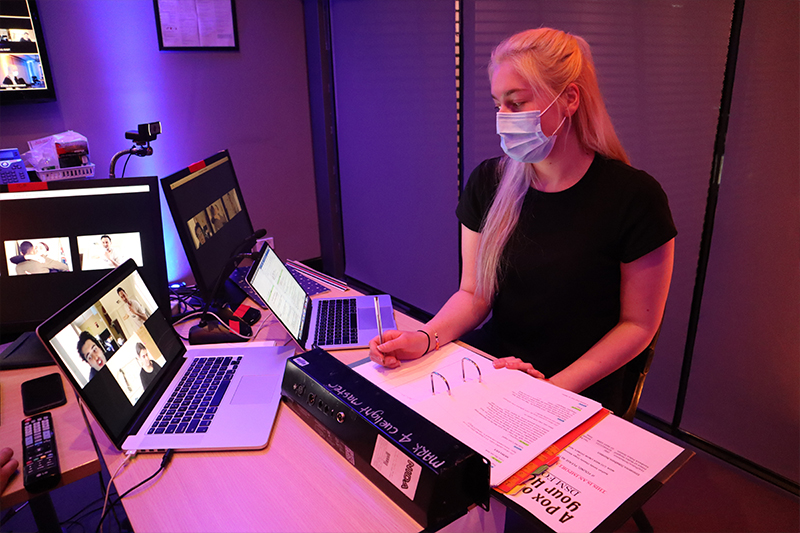
Written and directed by leading experimental Australian performance,theatreand installation artist Deborah Pollard,A Pox on Both Your Houses wasa three-part show broadcast on three separate nights over Zoom.
NIDA Bachelor of Fine Arts (Technical Theatre and Stage Management) studentsFiona Lloyd Harding (Technical Designer) and Isaac Barron (Technical Systems Supervisor)explainedthat while appearing simple forthe audience, the showcontainedover 250 video cues, 100 sound cues and operators viewing up to six screens at a time.
The goalwas to make this amount oftechnical productionentirelyinvisible to the audience. The technical team � Fiona Lloyd Harding, IsaacBarronand Jodi Rabinowitz �created a system using Open Broadcast Software (OBS),Teamviewerand Zoom tomodifyhow the cast appears on screen.
This system allows the team toposition the cast on the screen and overlay video content even though the actorsare located infourdifferent locations. Withgreen screens installed, over Zoom they calledintothesystemlocatedat NIDA.
The audio system allows for both the cast and audience to hear the score and sound effects. It also allows for the Stage Management � Nathan Sandy, and Sophie Jones � to talk to thecast and audience whilebeing on a Zoom call with both.
Live broadcastfrom four sets blended withpre-recorded film
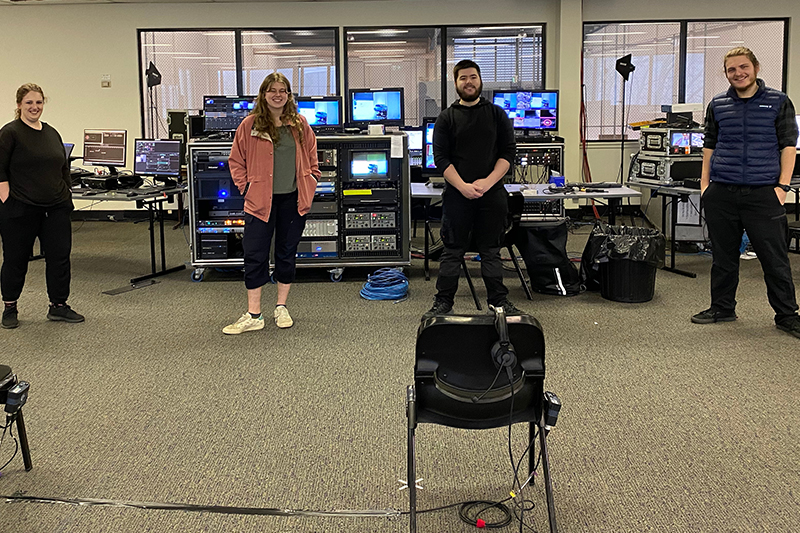
Lunacy waswritten and directed by NIDA Directingalumnusand multi-media writer Pierce Wilcox. It istechnically and logistically complex for several reasons, explainsNIDA Bachelor of Fine Arts (Technical Theatre and StageManagement)Thomas Houghtonwho has a staggering eight roles on the show -Technical Director, Swing SM, LX Designer, HLX, VX/SND System Des/Sup, Human Counterweight, Archive content designer, Assistant Archive content writer,and Website Developer.
The showbegins asking the audience to explore a custom-designedwebsite. The second partcombinesfilm and theatre,broadcast live from ahugewarehousein Alexandria.
The show is shotlivewith eight cameras whichsend feed to a central position,wherea Video Mixer, Lighting and Audio Mixers,Remote Camera, Media Server Operators and Show Caller controlit.
The video content iscreatedto a standard definition PAL formatwhichgivesitaolder’broadcast signal’ feeling.Theshow is then streamedforthe audience to view.
All Digital Theatre Festival shows are now online for you to watch free of charge until Sunday 20 September!
Feeling inspired?Find out more orapply now tostudy Technical Theatre and Stage Management at NIDA.

